
AI to Transform Quality Inspection Across Industries
Increasingly sophisticated deep learning algorithms now require fewer images to train, offering a more powerful tool for quality managers responsible for identifying defects.
ZOHAR KANTOR, QUALISENSE
The introduction of AI in fields such as quality inspection is the latest development in a wider transformation involving
the introduction of automation and
digitalization on the factory floor. Previous stages of this evolution have included the introduction of robots and collaborative robots, as well as the replacement of paper records with digital ones.
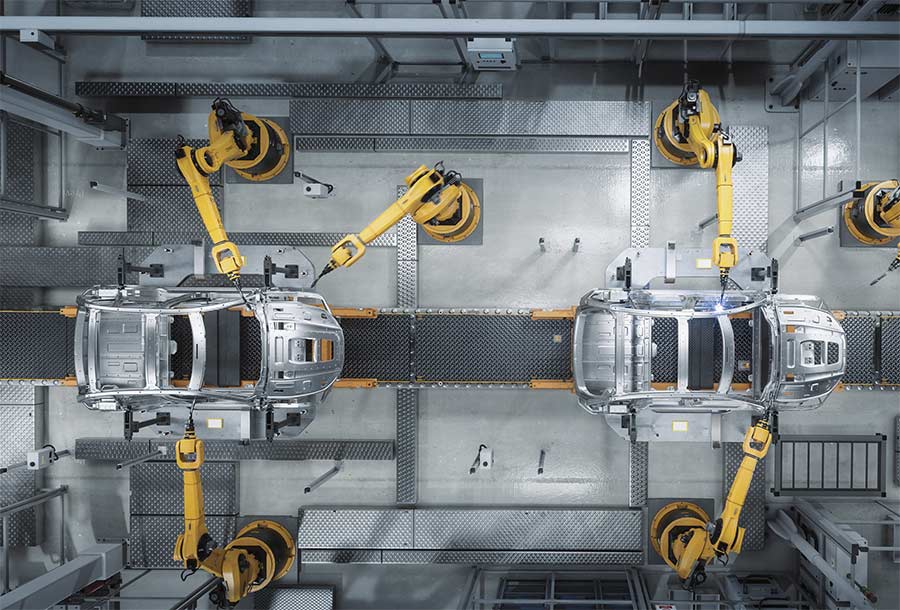
An aerial view of an automated robot arm assembly line manufacturing advanced, high-tech green energy electric vehicles. Courtesy of iStock.com/gorodenkoff.
The next phase will involve the
introduction of greater levels of automation and the use of AI to provide insights into data. The introduction of greater AI in quality inspection must be understood as part of this broader transformation.
The end of human inspectors?
Greater automation will inevitably disrupt traditional working patterns. The manual workers who perform visual inspection will be replaced. Even in parts of the world where labor costs are lower, such as China and India, automating manual inspection through the introduction of AI is already occurring. And it is not simply a cost-cutting exercise.
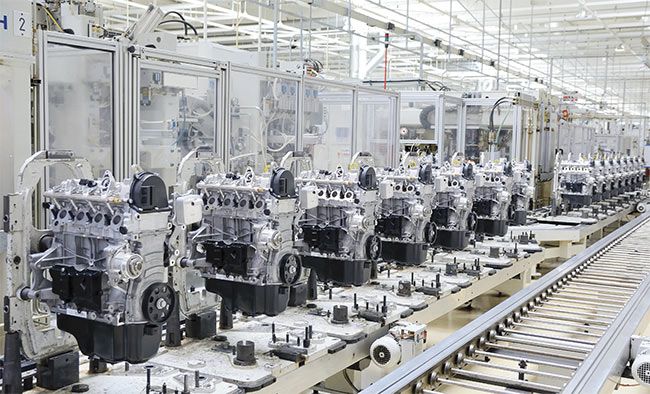
The automotive industry has no room for error when it comes to safety, reliability, and manufacturing efficiency. Advanced inspections catch even the most minor defects in engine parts. Courtesy of amik/Shutterstock.
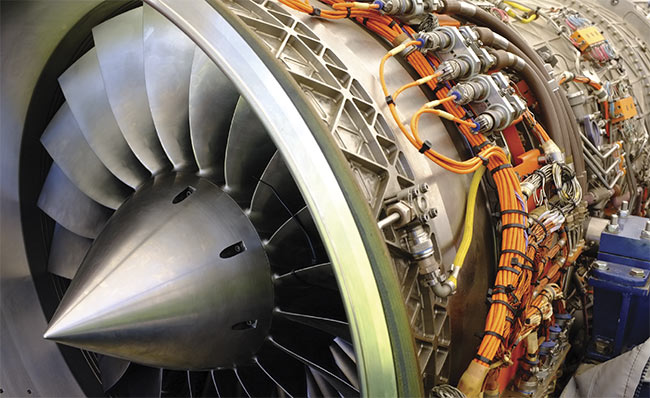
Wide-angle close-up of an aeronautical engine belonging to a Eurofighter Typhoon. Jet engines must be inspected closely for defects. Courtesy of iStock.com/Alan_Lagadu.
Estimates vary, but it is typical for human inspectors to have a mistake rate of 10%. In places where AI is being rolled out in quality control, the threshold for mistakes is usually <1%. Most human inspectors do not have the endurance or resilience to inspect two parts per second for several hours at a time. Given the pressure these workers are under, mistakes are inevitable. Human workers can make mistakes that machines are incapable of making. When there is a matter of only seconds to inspect a part and determine whether a defect is present, it is inevitable that the worker will make mistakes, given factors such as fatigue. In contrast to human workers, machines cannot suffer fatigue and remain consistent with minimal errors. They also are not subject to the cognitive biases that affect human judgement. Perhaps the most common in the field of inspection is what psychologists call immediacy bias. This refers to the tendency of human beings to be disproportionately influenced by the most recent thing he or she has seen. For example, if an inspector sees a crack in the top right corner, he or she is more likely to look for and expect that same defect in a subsequent part. An AI algorithm, by contrast, inspects each part objectively and factors such as this do not negatively affect the outcome.
The limits of rule-based inspection
Rule-based algorithms have been used in quality inspection for many years, but they are only effective for simple tasks. A simple rule-based algorithm might count the number of pixels in a square. If a certain number is exceeded, it will flag a potential defect. Rule-based algorithms are good at simpler tasks, but when variables such as changes to lighting or print fading are introduced, for example, the algorithm no longer suffices.
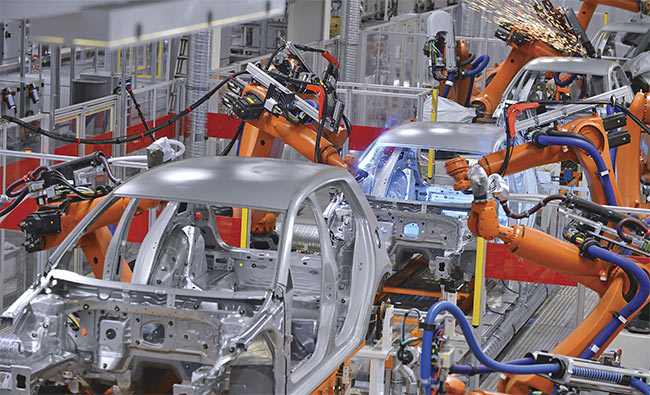
Robots welding in an automobile factory. Machine vision is used to detect pore sizes and the weld joint defects in automobile chassis. Courtesy of Stock.com/microolga.
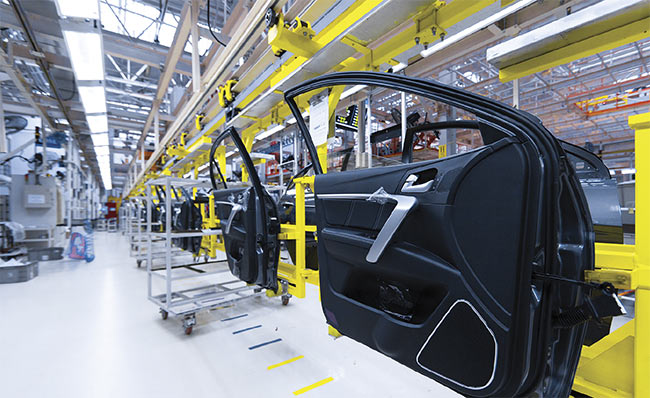
Preparation of doors for installation in a car factory. Courtesy of Stock.com/Traimak_Ivan.
More complex tasks therefore require deep learning algorithms. In contrast to rule-based systems, deep learning algorithms are based on a more general understanding of what constitutes a defect. To create this understanding, they are fed many images. The general understanding of a defect can then be applied to more specific tasks and the model will continue to learn and optimize through feedback.
Until recently, the number of images required to train a workable model was a challenge, because a high volume of pre-tagged images was needed. This process is often a long and arduous one. A recent breakthrough is the development of systems that bypass this time-consuming exercise through automating the process of model-
building. More sophisticated deep learning algorithms can be trained with fewer images and are designed to harness the knowledge of the quality manager, whose feedback ensures continued optimization while the model is deployed on the production line.
Another development that will strengthen the uptake of this technology is the continuing decline in the costs of hardware. Cameras, lighting apparatus, and other key machine vision components are becoming less expensive, allowing more and more companies to access the benefits of automating inspection. At the same time, software solutions that are designed to be compatible with any hardware, rather than requiring exclusive reliance on one vendor, are also entering the market. This will potentially allow companies to breathe new life into old investments.
Augmented AI is a concept that is gaining ground in many fields, as experts realize the need for human insight to supplement AI and vice versa. In the context of quality inspection, the quality manager has knowledge of the entire production process, and this knowledge is needed to provide the model feedback and ensure it is optimized effectively.
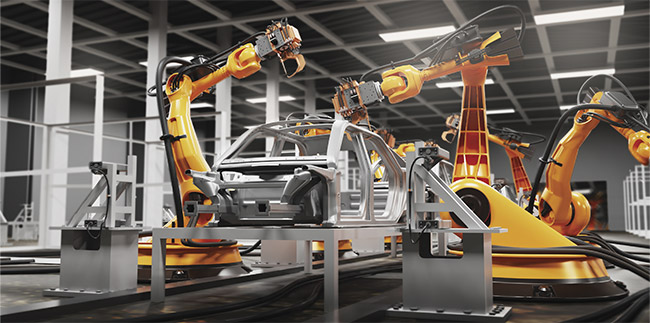
3D illustration of an automobile production line using robots to work in smart factories. Courtesy of Stock.com.
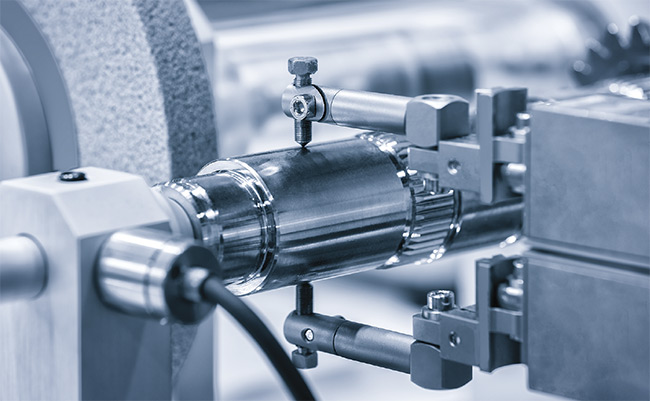
A CNC (computer numerical control) milling machine performs a machining process similar to drilling and cutting parts with precision to accommodate exact sizes and shapes of different materials. Machine vision, assisted by AI, performs quality control to ensure that there are no anomalies. Courtesy of Matveev Aleksandr/Shutterstock.
AI will certainly affect the role of the quality manager, but it will not replace him or her. Instead, AI will make quality managers’ jobs easier by allowing them to meet their targets. Augmented AI systems will rely on professionals for feedback to allow them to improve.
Until now, effective deployment of AI solutions has been dependent on AI experts and data professionals; if it did not perform as expected, an expert was needed to resolve the problem. Currently, the aim is to make this technology available and accessible to quality managers, removing the need for outside expertise. Further, because quality managers have knowledge of the production process, it is better that they are the providers of feedback to the model in any case.
AI will assist quality managers in achieving their primary objective of reducing the number of defective parts leaving their plant. It will also dramatically increase yield and reduce waste. The data gathered from the process also has the potential to deliver vast improvements in efficiency. Classifying various defects and storing data about their occurrence provides the opportunity for root cause analysis: addressing the cause of the problem and not just the symptoms.
Where will AI be introduced?
AI will first be introduced at the end of the production line. It is here that companies have the greatest need, and the introduction of AI will allow them to dramatically reduce the number of overlooked defects. This is especially important in industries in which there are high penalties for defects, such as automotive or aerospace. OEMs in these industries often have entire departments dedicated to filing claims when parts suppliers fail to fulfill their contractual obligations; therefore preventing defective parts leaving the factory becomes the priority.
The potential for AI to be introduced in preceding stages of the production process is also worth highlighting. Here, AI will not be replacing human workers — it will be operating in areas in which there was not inspection previously. When there are multiple stages in the production process, the ability to spot a defect at the earliest possible opportunity could lead to significant gains in efficiency and reductions in waste.
The data generated from AI provides additional value that human workers cannot offer. A manual inspector will simply determine a part is defective
and cast it aside. No data is stored pertaining to the type of defect or the frequency of it, because introducing this would significantly reduce throughput. Rather than replacing manual workers, AI is therefore completing additional tasks, allowing the quality manager to identify, for example, what type of defect is statistically the most common.
The industries that are most likely to realize the benefits of this first have a number of things in common. Industries in which mass production is the norm will see greater and quicker returns on investment, as the defect rate has a greater effect on operations at this scale. And sectors in which the cost of failure is highest, such as automotive, will enjoy greater benefits from this technology because the competitive advantage gained from reducing the defect rate is much higher.
Farther ahead
During the next few years, the relationship between the quality manager and the AI model will evolve. Currently, the quality professional is supervising or guiding the system to provide the feedback it needs to continue optimizing. In the next few years, it is likely that the system will be able to interact with the quality manager in a similar way that Bard or ChatGPT does, ensuring that the correct guidance is provided.
Perhaps the single greatest challenge to overcome in the meantime is the need for more data. Large numbers of images are needed for model training, whereas generative AI systems can be trained using data that is freely available on the internet. Systems that are capable of quality inspection need access to proprietary data that companies are not willing to hand over easily.
A related challenge is that, unlike
ChatGPT, an AI system for visual inspection is not generic. It is therefore impossible to train a system on open-source material, because it requires very specific data about production processes. To build a system capable
of supporting the production floor, a
significant vertical investment is
required.
The introduction of AI in quality
inspection is the latest stage in a wider transformation of manufacturing,
involving increasing automation and digitalization. This technology has an enormous potential for reducing
defects and increasing yield and
optimizing processes. Ultimately, the end users or customers stand to gain from these advancements. However, the transformation will likely lead to
the reduction of manual workers in
visual inspection tasks. Quality managers nevertheless should embrace
augmented AI as the tool that will
empower them to do their job with greater ease and efficiency.
Meet the author
Zohar Kantor is the chief revenue and customer success officer for QualiSense. Kantor has extensive experience driving the growth of Israeli tech startups and has played a crucial role in enabling renowned global brands to optimize efficiency through the implementation of AI-based solutions for defect inspection. Kantor earned a bachelor’s degree from the University
of East London and an MBA from Middlesex University; email: zohar.
[email protected].
/Buyers_Guide/QualiSense/c33759
Published: September 2023
Glossary
- machine vision
- Machine vision, also known as computer vision or computer sight, refers to the technology that enables machines, typically computers, to interpret and understand visual information from the world, much like the human visual system. It involves the development and application of algorithms and systems that allow machines to acquire, process, analyze, and make decisions based on visual data.
Key aspects of machine vision include:
Image acquisition: Machine vision systems use various...
- artificial intelligence
- The ability of a machine to perform certain complex functions normally associated with human intelligence, such as judgment, pattern recognition, understanding, learning, planning, and problem solving.
AIQualiSenseinspectionautomationFeaturesmachine visionartificial intelligence